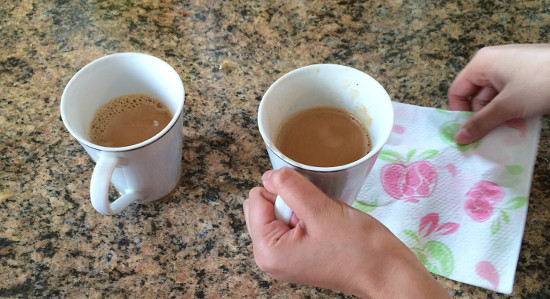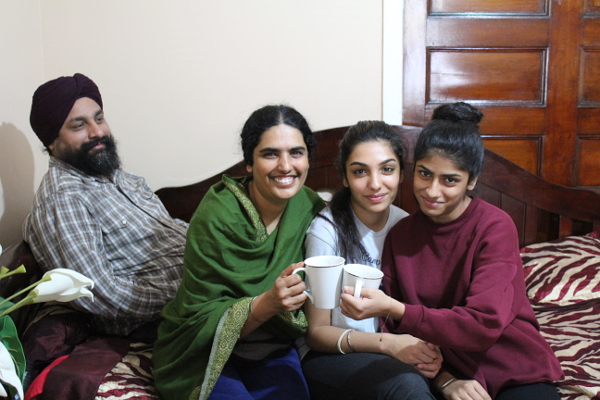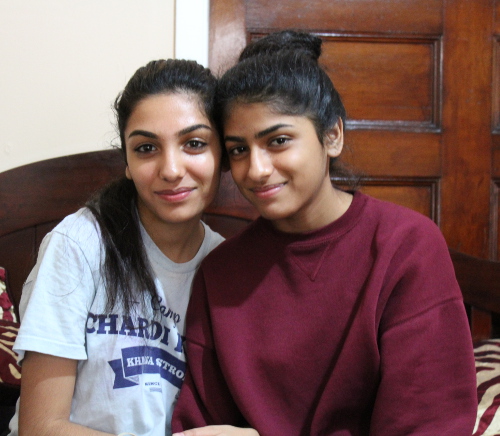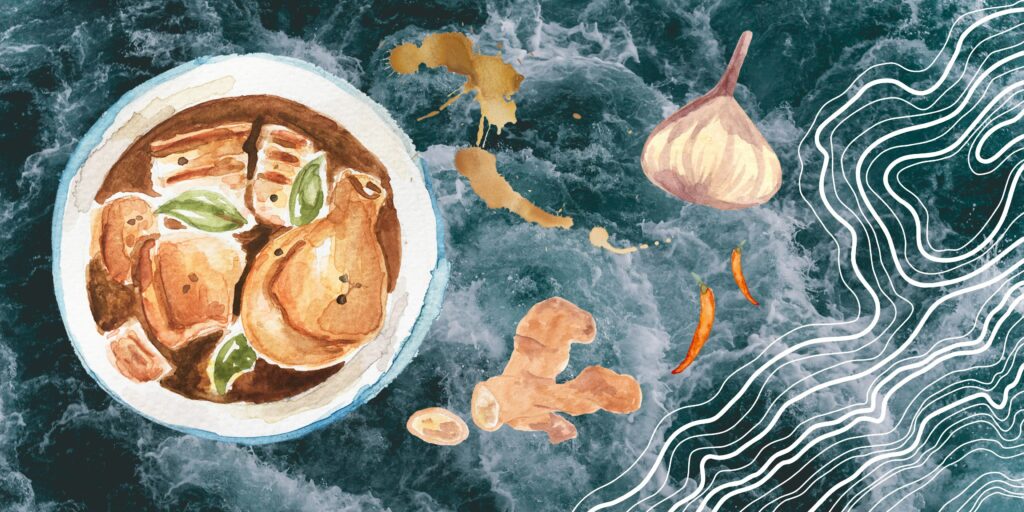Cha, chai or te? A Richmond Hill family’s multiple ways of preparing what Chinese philosopher Lao Tzu called “the elixir of life.”

February 25, 2016
Tea, next to water, is the most consumed drink in the world.
Millions, if not billions, of people from China to India, from England to the Caribbean, and from the East Coast to the West Coast, enjoy this hot, pick-me-up beverage also known as cha, chai or te in most of Asia.
Its universality, though, is also the reason for its diversity. Every culture has its own distinctive way of preparing this potion; every family has its own peculiar art of concocting this brew; and every person has a preferred technique of distilling and enjoying this decoction.
How do you like your tea then?
Curiosity and a chance to savor authentic tea motivated 2015 Open City Fellows Sonny Singh and Nadia Misir to find out how immigrants from different parts of the world enjoy their teas. They were given the privilege by two families to witness how they prepare their respective teas and to join them at tea time.
This is part 1 of a two-part series on what ancient Chinese philosopher Lao Tzu called “the elixir of life.”

“I like my cha,” Parminder Kaur said. “I don’t like the way most other people make it. I like it my way,” she explained to me, as she sat on a daybed next to her two daughters and husband in their Richmond Hill home.
Her 18-year-old daughter Anmol, wearing a t-shirt and sweatpants, chimed in with a chuckle, “I like the way I make it.”
Ms. Kaur and Anmol are the two most regular cha drinkers in the family, though everyone enjoys it. Cha is Punjabi for tea.
“I’m the only one who drinks it all the time,” Ms. Kaur explained. “When I come home from work and haven’t had cha, I’ll get a headache. Then I need it in the morning to wake up, too.”
Anmol, a senior at Aviation High School in Flushing, drinks cha every morning, while her two younger siblings drink it on weekends only.
“I remember my mom taught it to me how to make cha,” Anmol recalled. “Or was it Nani [maternal grandmother]?”
“I don’t know, but someone taught me how to make tea. It came out really good. I like my cha to be little whiter [than my mom’s]. I like it really milky,” Anmol added.
“While commercial production and mass consumption of tea arrived in India in the 19th century with British colonialism, regional and medicinal tea drinking is documented as early as 750 BCE.”
I followed Ms. Kaur and Anmol in the kitchen, excited to join them for a late Sunday morning cup of cha and see how they make it. They fumbled around with ingredients and utensils for a bit, discussing in Punjabi who is going to make the tea.
“You can do it,” Ms. Kaur said, as she began pounding green cardamom pods and fresh ginger in a wooden mortar and pestle on the counter.
Anmol filled a teacup with tap water and poured it into a steel pot on the stove. Ms. Kaur allowed her daughter to take the lead, but stayed involved. Anmol scooped out a spoon of ground black tea leaves out of a stainless steel jar and dropped it into the water, which had begun to simmer.
Her mom emptied the paste of ginger and cardamom into the pot, as Anmol turned up the heat on the gas stove. Anmol then dropped in two generous scoops of white sugar, using what resembles a soup spoon from a Chinese restaurant. Ms. Kaur smirked, appearing to disapprove of the amount of sugar her daughter put in, but doesn’t say anything.
Finally, Anmol added a teacup full of whole milk into the pot. As it began to simmer, she turned up the heat again, saying, “I like to let it boil up three times.”

She slowly turned the flame up until the milky tea almost boiled over and then turned it back down. She repeated two more times, and then said, “It’s done.”
She handed the pot to her mom, who swirled the liquid around over the sink for a few seconds to cool it down before handing it back to her. Anmol poured the creamy, fragrant tea through a fine mesh strainer into one of the mugs until it is full. She began filling the second mug, but there was only enough to fill it halfway.
Anmol laughed and said, “I’m not the ideal housewife, sorry.”
Her mom said, “It’s okay,” and poured some of the steaming water from the full cup into the half cup, leveling them out at three-quarters each.
“It’s perfect,” I said, excited to have my first cha of the day.
Cha Origins
Tea—or chai in Hindi, cha in Punjabi—is South Asia’s most popular beverage. India alone drinks 837,000 tons of it every year, according to a BBC story, and is the world’s second largest tea producer, next to China. While commercial production and mass consumption of tea arrived in India in the 19th century with British colonialism, regional and medicinal tea drinking is documented as early as 750 BCE. And today, India is the world’s largest consumer of tea—accounting for 30 percent of all tea drank globally.
And that number does not include those guzzling down cha in the diaspora, like Parminder Kaur and her family.
Cha has been a part of Parminder Kaur’s life for as long as she can remember. “Since I was two, or three or four, I’ve been drinking it every morning,” she said. “You know how they give kids the bottle of milk? I think my mom used to mix milk and tea in my bottle,” she said, laughing.
Ms. Kaur picked up cha-making when she was eight or nine years old, simply by being surrounded by her mom and other relatives making it twice a day in her Indian state of Haryana.
“In India everyone drinks it together at one time in the morning and one time in the afternoon. Over here, I just make it for myself. It’s not a social thing.”
Here in Queens, her 15-year-old daughter Avneet had cha for the first time at the age of eight. “I remember my Mama Ji [mother’s brother] made me drink it. It was really hot and it burned my tongue,” she said.
Eventually Avneet, who, like her older sister and younger brother, was born and raised in Richmond Hill, tried making cha a few years ago. “It was for my mom, and I didn’t know how to make it,” she said. “So I put a lot of sugar and a lot of the pathi [leaves]. And I put my dad’s special sugar—Splenda—and it tasted really bad.”
Her mom laughed and said, “Karanbir [her 11-year-old son] is the only one who knew how to make tea since he was five, and his tea is really excellent. He makes it better than anyone,” she said with pride.
Her husband, Jasdeep Singh, chimed in. “He makes it good when he makes one cup. He only knows how to make one cup. If he does two cups, it’s no good.”
Everyone laughed, but Ms. Kaur insisted that “his is the best one.”
“Karanbir!” his mom yelled across the apartment. “Ithay aao! [come here].”

A smiling Karanbir with long wavy hair just washed, shyly joined us in the living room and sat next to his mom.
“When I was seven, I saw my mom making cha,” Karanbir said softly. “And I was interested in making it. I don’t remember when I started drinking it.”
His mom explained. “On weekdays, they don’t drink it before school, you know. They just have milk or something, except for Anmol. But on the weekends, when we have paronthay, they like to drink cha. And Karanbir makes it for me whenever I ask him to,” she said, smiling.
Unlike his wife, Mr. Singh does not need cha to perk him up in the morning. “I like just hot water in the morning,” he says matter-of-factly. “And aloe vera juice.”
For Mr. Singh, however, cha plays an important role in his job as a taxi driver who works night shifts. “I’m still tired,” he said. “Last night, Saturday night, was very busy, driving all over. I go to Punjabi Deli [on Houston and Ave. A in Manhattan] and get cha or desi coffee usually – one or two times at night when I work from four p.m. to four a.m. Yesterday night, I didn’t have much time, so at nine, I took one break and had one cup cha and a pinni [a Punjabi multigrain sweet].”
“It’s different here than in India,” Mr. Singh continued. “Everybody has different schedules, wakes up at different times so we don’t usually have cha together. But in India we make cha in a big patheela [pot],” he explained, extending his arms to form a two-foot circle approximating the size of the patheela. “Twenty or thirty cups! For everybody.”
Ms. Kaur agreed. “Yes, in India everyone drinks it together at one time in the morning and one time in the afternoon. Over here, I just make it for myself. It’s not a social thing.”
“But if family comes over, everyone is going to sit around and have cha,” Anmol reminded her parents.
Her mom nodded. “Yes, when a guest comes, we’re going to offer them cha. But in daily life, it’s not social.”
“I’ve already had it two times today,” Ms. Kaur said, laughing. It was only 11:30 in the morning.
“When I have to do extra work, I need extra cha. I made so much food this morning. I wanted to feel good, so I had more tea because I’m addicted.”
Her husband responded, smiling, “She can’t work without tea.”
Cha Preferences and Variations

“I like somph [fennel seeds], dalcheeni [cinnamon], ajwain [carom seeds], pudina [mint], laichi [cardamom], adhrak [ginger],” Mr. Singh said.
“You should see him when he makes an omelet,” said Anmol. “He puts everything in it.”
For Ms. Kaur, it’s all about the tea. “I want to taste my tea, not all the masalas. I only like cardamom and ginger, I don’t like all those other things in my tea.”
From my own experience, cha at the Richmond Hill gurdwaras and in other Punjabi households I’ve visited in the neighborhood always has a very strong taste of fennel seeds. So I was surprised about its absence from the cup in front of me.
“That’s a very Punjabi thing,” Ms. Kaur explained. “And I’m from Haryana. The Punjabis in Richmond Hill grew up with that somph [fennel seed] taste. In India it’s much less expensive than the other spices, so everyone uses it. I don’t like it.”
Mr. Singh suddenly shifted into discussing the health benefits of cha: “If you put a little loon [salt] in your cha, you cannot get gas. Other tea sometimes gives you gas. You put salt, no gas,” he said, while Anmol and Avneet look slightly embarrassed.
Ms. Kaur nodded and added: “If your stomach is upset or something, if you have loose motion or anything, put some pudina and ajwain in your cha, and it gets better. In 15 or 20 minutes, you feel better.”
“There’s some doctor on the TV, some Pakistani homeopathic doctor,” Mr. Singh said, “who says if you have ajwain (carom seeds), it’s good for your digestion.”
I told them about my skepticism to putting salt or the extremely pungent ajwain in my cha. Mr. Singh offered to make me a cup to try, but I’m quite content sipping on extra sweet gingery cardamomy cup that Anmol and her mom prepared for me.
Cha Away From Home
Ms. Kaur said sometimes she has to get tea outside of the home in order to make it through the day. “It doesn’t taste the same, but sometimes when I’m out at work or wherever I’ll just use teabags in a cup [rather than boiling everything together in a pot],” she said. “I’ll just use two or three teabags. One won’t do it.”
Anmol chimed in: “I tried just boiled water with a tea bag and adding milk once, but it didn’t taste the same.”
“I liked the chai at Dunkin Donuts,” her mom said. “When I tasted it, it reminded me of some pink drink in India. It’s not tea tea, but it’s good. I think they call it desi chai at the Dunkin Donuts in India. There’s no cha pathi [tea leaves] in there at all. I don’t know what it is. But I like it. Whenever I see ‘chai’ in some cafe or something, I try it.”
Surprised that Ms. Kaur likes the Dunkin Donuts variety, I asked about Starbucks. Somewhat to my relief, no one in the family has tried their “chai latte” or “Oprah chai.”
“Starbucks coffee is very strong,” Mr. Singh piped in.
“I don’t really go to Starbucks,” Anmol said. “I don’t like coffee at all, it’s like too strong. I’ve had chai at Dunkin Donuts. It tasted okaaay, but it was different.”
Avneet declared: “Cha is for home, coffee is for outside.”
I nodded and gulped down the last of my cha, feeling nourished, caffeinated, and at home.
Recipes
Parminder Kaur’s cha (for 1 cup)
Put ¾ cup water in a small to medium pot on high heat. While it’s heating up, grind about an inch of fresh ginger and one to two green cardamom pods in a mortar and pestle. Add the ginger and cardamom to the water once it’s simmering. Add ¾ teaspoon of loose black tea leaves (she uses Wagh Bakri), then one spoon of sugar. After it has boiled rapidly for a few minutes, add about ¼ cup of whole milk. Then let it boil for just about a minute, until it bubbles up. Pour through a sieve, and serve.
Anmol Kaur’s cha (for 1 cup)
Put ½ cup of water in a small to medium pot on high heat. Add ½ teaspoon of black tea leaves into the pot once the water it boiling. Then add the two to three cardamom pods and a little fresh ginger. Break the cardamom pod open by rolling over it with a rolling pin (the mortar and pestle is too much work, she says). After the tea has boiled for a minute or two, add a little bit more than ½ cup of whole milk. Then let it boil up three times, raising and lowering the heat to get it to rise and fall. Pour through a sieve, and serve.



